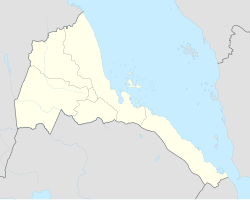Debarwa
Debarwa
ድባርዋ دباروا | |
|---|---|
Market town | |
 The church of Debarwa | |
| Coordinates: 15°06′N 38°50′E / 15.100°N 38.833°E | |
| Country | |
| Region | Debub |
| District | Debarwa |
| Population | |
| • Total | 25,000 |
| Time zone | UTC+3 (EAT) |
Debarwa (Tigrinya: ድባርዋ Tigrinya pronunciation: [dɨbarwa]) is a market town in central Eritrea. It is situated about 25 kilometers south of the capital Asmara, and has a population of about 25,000 inhabitants.[1] It is the capital of the Debarwa district (Tsilima) in the Debub ("Southern") administrative region (one of five in Eritrea).
History
[edit]Debarwa was one of the most important settlements in northern Ethiopia during the medieval era. An Ethiopian monk, Brother Antonio, told the Venetian scholar Alessandro Zorzi in the 1520's that it was the "chief city" and residence of the Bahr Negash, Francisco Álvares, who visited the town at the same time describes that it was the site of the ruler's "principal palaces". The area was disrupted in 1535 when Ahmed Gragn overran the region. The Portuguese expedition under Cristóvão da Gama spent the rainy season of 1542 in Debarwa, Miguel Castanhoso, a member of the Portuguese force, found the region "depopulated through fears of the Moors", for "the inhabitants had taken refuge with their herds on a mountain."[2] The seizure of Massawa by the Ottomans in 1557 and their subsequent advance inland led to further difficulties. The Turks soon occupied Deberwa, but due to the resistance of the local population they were forced to retreat back to Massawa.[3][4]
Conflict flared up again in 1561, during the reign of Emperor Menas who was in bad relations with the Bahr Negash Yeshaq. The latter according to James Bruce, rebelled against the Emperor and upon being defeated "threw himself at the mercy of the Turks." At the price of their help he ceded Deberwa to the Turks. In 1576 the Ethiopian Emperor Sarsa Dengel attacked Debarwa whereupon the Turkish garrison surrendered with all its firearms. Sarsa Dengel then seized the vast riches stored by the Turks in Debarwa and ordered the destruction of the mosque and the fort that was erected during the Ottoman occupation.[5] In 1587, the Turks left the port of Hirgigo and advanced inland to take Debarwa again but was again defeated by Sarsa Dengel who killed the Turkish commander Kadawred Pasha in battle.[6][7]
The French traveller Charles-Jacques Poncet visited the town in 1700 and described it as being "the capital of the kingdom of Tigray". Though still a flourishing political and commercial center in Poncet's day, Debarwa was beginning to be overshadowed by the more southernly town of Adwa, which soon became the main metropolis of northern Ethiopia. With the decline of Debarwa, the status of the Bahr Negash further dwindled. Poncet noted that the office had been divided with two separate officials bearing the title who established themselves in different localities.[8]
The city was hit hard by a typhus epidemic in 1893, which followed the misery of the Great Famine (1888-1892). A French visitor described Debarwa as "decimated", and all that was left of the once prosperous town were "a few piles of stones, an almost ruined church, and a few wretched hovels".[9]
Demographics
[edit]The majority of the population in Debarwa belongs to the Bihér-Tigrigna (Tigrinya-speaking) ethnic group. In terms of faith, local residents are mainly adherents of the Eritrean Orthodox Tewahdo Church.
Economy
[edit]Local people bring produce such as potatoes, tomatoes, chickens and grain to the market every Saturday. Aside from being a market town, it is also a mining town with resources of high grade gold, copper, silver and zinc, and an important transport route between the south-west corner of Zoba Debub and Asmara. The Japanese company Hitachi once operated a mine near Debarwa, but it was shut down in the 1960s due to the outbreak of the Eritrean War of Independence from Ethiopia.[citation needed]
References
[edit]- ^ Older writers, such as Samuel Purchas, often use a corrupt form of its name, "Barua".
- ^ R.S. Whiteway, editor and translator, The Portuguese Expedition to Abyssinia in 1441-1543, 1902. (Nendeln, Liechtenstein: Kraus Reprint, 1967), pp. xlvif, 9
- ^ Richard Pankhurst, The Ethiopian Borderlands (Trenton: Red Sea Press, 1997), pp. 234-238
- ^ Pankhurst, Richard (1982). History Of Ethiopian Towns. p. 67. ISBN 9783515032049.
- ^ Pankhurst, Richard (1997). The Ethiopian Highlands. p. 236. ISBN 9780932415196.
- ^ Pankhurst, Richard (1997). The Ethiopian Highlands. p. 239. ISBN 9780932415196.
- ^ Pankhurst, Richard (1982). History Of Ethiopian Towns. p. 68. ISBN 9783515032049.
- ^ Pankhurst, Richard (1982). History Of Ethiopian Towns. p. 70. ISBN 9783515032049.
- ^ Richard Pankhurst, An Introduction to the Medical History of Ethiopia (Trenton: Red Sea Press, 1990), p. 36

